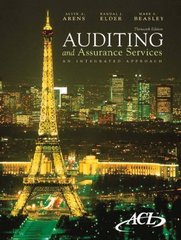Question
7. A company issued to certain employees 1,000 shares of stock option awards. The grand-date market price is $11 per share, exercise price is $10
7. A company issued to certain employees 1,000 shares of stock option awards. The grand-date market price is $11 per share, exercise price is $10 per share, and the fair value of the options based on the Black-Scholes option-pricing model is $10 per share. A performance condition is included such that the employee will vest 70% in the awards if cumulative net income is greater than $5 million in the succeeding two-year period, and 30% if otherwise. The company believes it is likely that it will exceed the $5 million income target. The company also indicates that the fair value of the option factoring performance condition is $8.
a. Under the (old) intrinsic value method, how much compensation expense should be record for the first year?
b. Under the (current) fair value method, which fair value and how many shares should be used in calculating compensation expense? How much compensation should the company record for the first year?
8. Murray Compensation, Inc. issued 100,000 employee share option on 1/1/2016. The grand-date market price is $21 per share, exercise price is also $21 per share, and the fair value of the options is $6 per share. Due to the significant decrease in stock price, the fair value of the option dropped to $3 per share as of 1/1/18. As a result, Murray decreased the exercise price of the option to from $21 to $12 per share. With the re-pricing, the fair value is now $5 per share. How much additional compensation should be record?
9. For the example below, list and describe the input(s) (observable or unobservable) and valuation technique(s) used. Determine the appropriate classification in the fair value hierarchy. Company A invested in the common stock of a private furniture manufacturer, Company Z. Quoted prices are not available for Company Zs stock. Company Zs fair value is measured as the present value of future cash flow. The measurement requires management assumptions such as discount rate, amount and the timing of future cash flow.
Step by Step Solution
There are 3 Steps involved in it
Step: 1

Get Instant Access to Expert-Tailored Solutions
See step-by-step solutions with expert insights and AI powered tools for academic success
Step: 2

Step: 3

Ace Your Homework with AI
Get the answers you need in no time with our AI-driven, step-by-step assistance
Get Started


